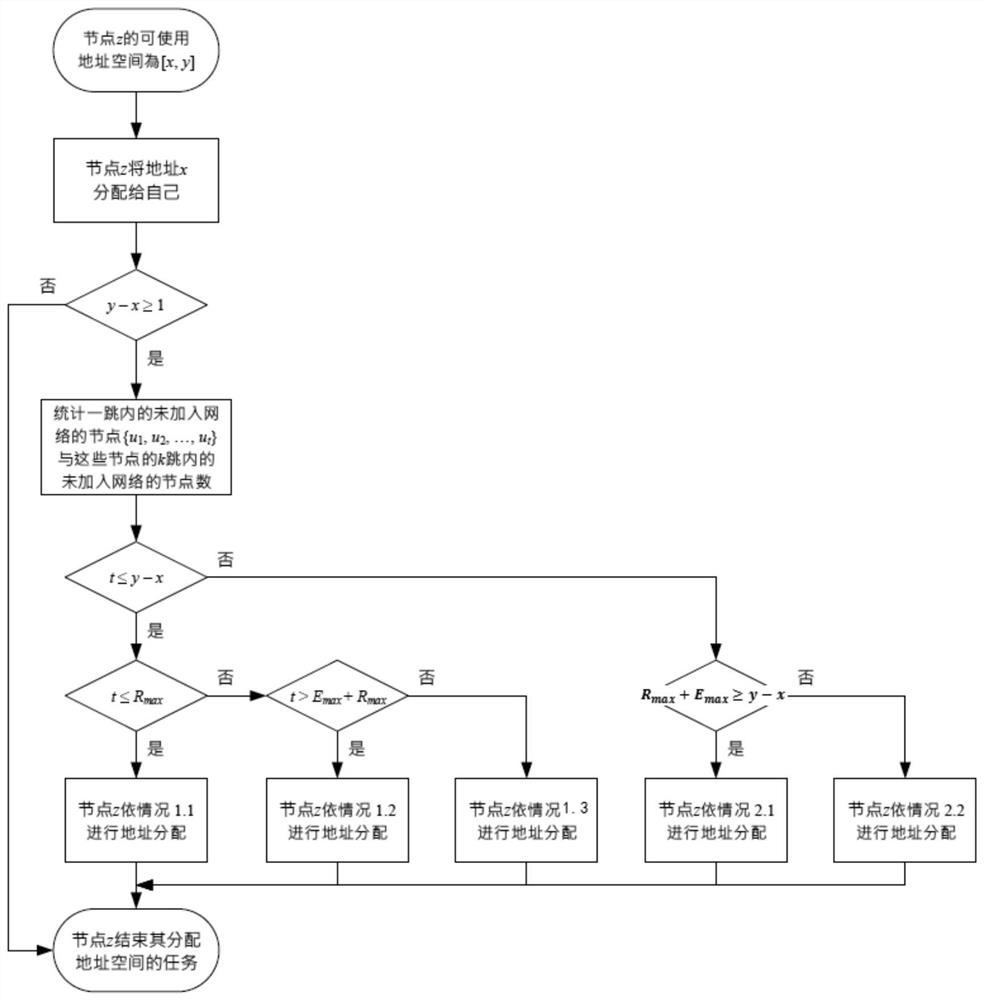A Tree Network Address Method Based on Address Space
An address space, tree network technology, applied in the field of network communication, can solve the problems of incomplete preservation of "location-address" relationship, waste, optimization of network topology structure, etc.
- Summary
- Abstract
- Description
- Claims
- Application Information
AI Technical Summary
Problems solved by technology
Method used
Image
Examples
Embodiment 1
[0051] Suppose the coordinator node decides that the available address range is [0, 10000] and decides k=2, R max =3,E max After =2 three parameters, inquire whether the nodes that have not joined the network within one hop join the network, and ask these nodes to count and reply the number of nodes that have not joined the network within 2 hops of the node respectively. Assume that the set of nodes that have not joined the network within one hop of the coordinator node is {u 1 , u 2 ,...,u 7}, and u 1 [2]=9, u 2 [2]=6, u 3 [2]=5, u 4 [2]=4, u 5 [2]=4, u 6 [2]=3, u 7 [2]=2. Then the coordinator node allocates address space [9999, 9999] to node u according to the above method 6 , allocate address space [10000, 10000] to node u 7 . Then calculate c 1 =4500, c 2 =2999,c 3 = 2499, and assign address space [1, 4500] to node u 1 , allocate address space [4501, 7499] to node u 2 , allocate address space [7450, 9998] to node u 3 . Simultaneously k, R max , E max ...
Embodiment 2
[0053] Suppose the coordinator node decides that the available address range is [0, 10000] and decides k=2, R max =6,E max After =2 three parameters, inquire whether the nodes that have not joined the network within one hop join the network, and ask these nodes to count and reply the number of nodes that have not joined the network within 2 hops of the node respectively. Assume that the set of nodes that have not joined the network within one hop of the coordinator node is {u 1 , u 2 ,...,u 5}, and u 1 [2]=9, u 2 [2]=6, u 3 [2]=5, u 4 [2]=4, u 5 [2]=4. Then calculate c 1 =3217,c 2 =2142,c 3 =1785,c 4 =1428,c 5 = 1428, and assign address space [1, 3217] to node u 1 , assign address space [3218, 5359] to node u 2 , assign address space [5360, 7144] to node u 3 , allocate address space [7145, 8572] to node u 4 , allocate address space [8573, 10000] to node u 5 . Simultaneously k, R max ,E max Three parameters are sent to u 1 , u 2 ,...,u 5 , and set its ow...
Embodiment 3
[0055] Suppose the coordinator node decides that the available address range is [0, 10000] and decides k=2, R max =6,E maxAfter =2 three parameters, inquire whether the nodes that have not joined the network within one hop join the network, and ask these nodes to count and reply the number of nodes that have not joined the network within 2 hops of the node respectively. Assume that the set of nodes that have not joined the network within one hop of the coordinator node is {u 1 , u 2 ,...,u 7}, and u 1 [2]=9, u 2 [2]=6, u 3 [2]=5, u 4 [2]=4, u 5 [2]=4, u 6 [2]=3, u 7 [2]=2. Then the coordinator node allocates the address space [10000, 10000] to node u according to the above method 7 . Then calculate c 1 =2905,c 2 =1935,c 3 =1612,c 4 =1290,c 5 =1290, c 6 =967, and assign address space [1, 2905] to node u 1 , assign address space [2906, 4840] to node u 2 , allocate address space [4841, 6452] to node u 3 , assign address space [6453, 7742] to node u 4 , alloc...
PUM
 Login to View More
Login to View More Abstract
Description
Claims
Application Information
 Login to View More
Login to View More - R&D
- Intellectual Property
- Life Sciences
- Materials
- Tech Scout
- Unparalleled Data Quality
- Higher Quality Content
- 60% Fewer Hallucinations
Browse by: Latest US Patents, China's latest patents, Technical Efficacy Thesaurus, Application Domain, Technology Topic, Popular Technical Reports.
© 2025 PatSnap. All rights reserved.Legal|Privacy policy|Modern Slavery Act Transparency Statement|Sitemap|About US| Contact US: help@patsnap.com



